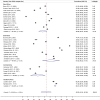Prevalence of key breastfeeding indicators in 29 sub-Saharan African countries: a meta-analysis of demographic and health surveys (2010-2015)
- PMID: 29070635
- PMCID: PMC5665288
- DOI: 10.1136/bmjopen-2016-014145
Prevalence of key breastfeeding indicators in 29 sub-Saharan African countries: a meta-analysis of demographic and health surveys (2010-2015)
Abstract
Objectives: To carry out a meta-analysis to assess the prevalence of four key breastfeeding indicators in four subregions of 29 sub-Saharan African countries.
Design, settings and participants: The 29 countries were categorised into four subregions, and using cross-sectional data from the most recent Demographic and Health Surveys (2010-2015) of these countries prevalence of each of four key breastfeeding indicators was estimated for each of the subregions by carrying out a meta-analysis. Due to the presence of significant heterogeneity among the various surveys (I2>50%), a random-effect analytic model was used, and sensitivity analysis was performed to examine the effects of outliers.
Main outcome variables: Early initiation of breast feeding, exclusive breast feeding, predominant breast feeding and bottle feeding.
Results: The overall prevalence of early initiation of breast feeding varied between a lowest of 37.84% (95% CI 24.62 to 51.05) in Central Africa to a highest of 69.31% (95% CI 67.65 to 70.97) in Southern Africa; the overall prevalence of exclusive breast feeding ranged between a lowest of 23.70% (95% CI 5.37 to 42.03) in Central Africa to a highest of 56.57% (95% CI 53.50 to 59.95) in Southern Africa; the overall prevalence of predominant breast feeding ranged between a lowest of 17.63% (95% CI 12.70 to 22.55) in East Africa and a highest of 46.37% (95% CI 37.22 to 55.52) in West Africa; while the prevalence of bottle feeding varied between a lowest of 8.17% (95% CI 5.51 to 10.84) in West Africa and a highest of 30.05% (95% CI 28.42 to 31.69) in Southern Africa.
Conclusions: West Africa and Central Africa recorded lower overall prevalence of early initiation of breast feeding and exclusive breast feeding than the WHO's recommended target of 50% by the year 2025. Intervention for improved breastfeeding practices in sub-Saharan Africa should target West and Central Africa, while intervention to minimise bottle feeding should target Southern Africa.
Keywords: community child health; epidemiology; health policy.
© Article author(s) (or their employer(s) unless otherwise stated in the text of the article) 2017. All rights reserved. No commercial use is permitted unless otherwise expressly granted.
Conflict of interest statement
Competing interests: None declared.
Figures





References
-
- Unicef for child. Improving breastfeeding, complementary foods and feeding practices. https://www.unicef.org/nutrition/index_breastfeeding.html
-
- USAID. Nutrition in the first 1,000 days. New York, USA: USAID, 2012.
-
- WHO. Exclusive breastfeeding Nutrition. http://www.who.int/nutrition/topics/exclusive_breastfeeding/en/
-
- León-Cava N, Lutter C, Ross J, et al. . Quantifying the benefits of breastfeeding: a summary of the evidence. PAHO Washington, DC, 2002.
-
- Horta BL, Bahl R, Martines JC, et al. . Evidence on the long-term effects of breastfeeding: systematic reviews and meta-analyses. Geneva: World Health Organization, 2007.
Publication types
MeSH terms
LinkOut - more resources
Full Text Sources
Other Literature Sources
Medical
